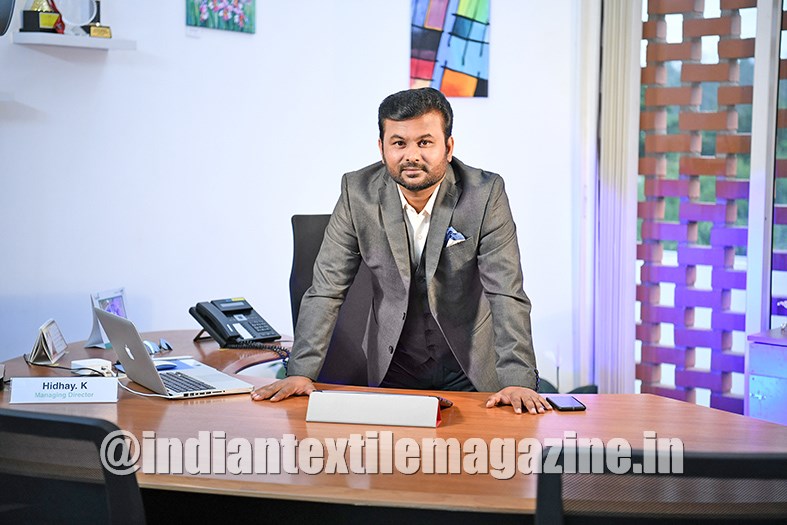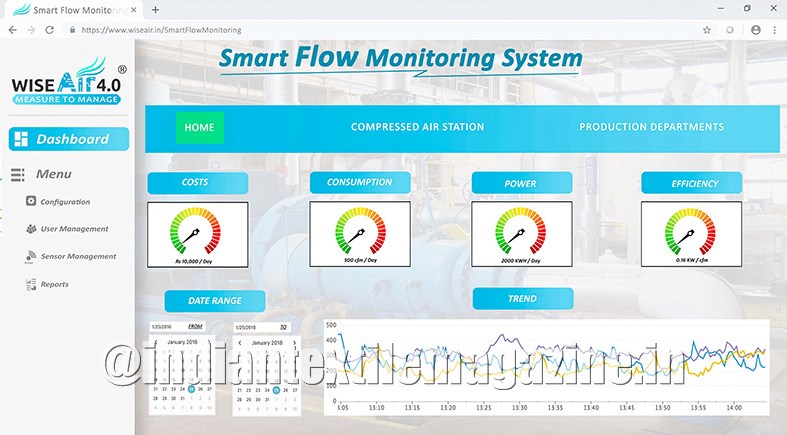Compressed air is the second largest utility for any textile factory and is also the most inefficient due to its Mismanagement. While a spinning mill spends close to 5-10% of its total energy consumption for compressors, an air jet weaving mill spends close to 50-60% of its energy consumption for compressors. In a compressor’s life cycle nearly 85% of the costs are for its energy whereas the capital and maintenance costs contribute only to 8% and 7% respectively. Hence proper management of compressed air systems will lead to significant cost reduction opportunities to the textile industries.
The Systel Group, a Coimbatore-based company founded in 2002 by Mr. Hidhay K., is a prominent player in the compressed air management market with over 1,550 compressed air improvement projects all across Asia, Europe and North America. The company offers a wide range of services starting from assessing the compressed air facilities to developing & implementing measures for a long term sustainable energy efficiency in the compressed air systems. On the product front, Systel Group offers smart compressed air monitoring solutions like artificial intelligence-based compressor master controllers, flow sensors, dew point sensors, leak detectors and realtime consumption monitoring softwares.
We spoke to Mr. Hidhay, Managing Director, Systel Group of Companies, to understand how their products and solutions can help the textile industries lower their compressed air costs.
Kindly brief us about the company, its specialisation and the services that your company offers.
Systel Group is headquartered in Coimbatore, with Research & Development Facilities in Copenhagen, Denmark. We promote the idea that continuous monitoring results in compressed air system awareness and will form the basis for any improvement programs. Hence we aim to simplify compressed air systems to help the end users improve their system’s performance, reliability and efficiency.
Systel’s capabilities start with its ability to assess any compressed air system deficiencies and develop simple but effective strategies to improve the system. With our smart monitoring technologies, the user’s are well informed about any deterioration in the performance of their compressors, dryers, filtration or pneumatic components.
How is compressed air management evolving today with the textile industry?
The industry has evolved a lot in understanding the true costs associated with compressed air. But still during a new system purchase the focus is always on the capital costs with only theoretical considerations of the specific energy consumption. Specific energy consumption is a term used to define the amount of power a compressor consumes to deliver an output unit of compressed air. While most of the end users measure the compressor’s power consumption, the compressors output flow remains unmeasured leading to factual errors in the assumptions about their compressor’s specific energy consumption. The ambient conditions coupled with the inefficiency and tolerance factors that are built into a compressor can take a toll on its energy consumption and in times may increase the specific energy consumption by even upto 30% of the compressor’s claimed efficiency. Hence consistent monitoring of a compressor’s power consumption and discharge flow will form a key to maintain the supply side efficiency.
What do you think are the root causes of compressed air system inefficiency?
It all starts with lack of performance validation of the equipments used in a compressed air system. Performance claims are usually not real in shop floor conditions and since the end users do not possess either the methodology or adequate instruments, these inefficiencies build up over time. Leakages are the major source of energy loss in a textile factory. Leaks occur due to faster worn out of components which are primarily due to high moisture contamination in the system. Hence ensuring low pressure dew points at the dryers (with accurate pressure dew point sensors) will eliminate the occurrence of leaks. Secondly leaks also occur due to poor maintenance practices and can only be managed at a low level by proper training to the factory technicians and deploying intelligent monitoring systems.
What are your suggestion to the industry?
For peak operating efficiencies, the user’s should define the key performance indicators of their compressed air like flow, power, pressure, dew point and should measure at the right locations to understand the overall system dynamics. The supply side of the system when improperly aligned with the demand side will result in over compensation of system pressures and will increase artificial demand and related problems like:
- Higher air demand
- Higher leak rate
- Higher repair intervals and costs
- Higher energy bills
- Higher cost per product produced
- And lesser profits
Hence defining the baselines and continuous tracking becomes inevitable.
What is your vision for Systel ?
We have an ambitious plan to become the No.1 player in India’s compressed air management market by 2022 and have committed for large investments towards our Research & Development. We already have an exciting line up of innovative & cost effective product launches for 2019. Further we have also set up an academy with state-of-the-art infrastructure at our Coimbatore premises to train and certify the textile technicians with the best practices in compressed air systems. This certification course is available completely free for the textile industries for the calendar year 2019. Experienced and renowned faculties from Asia, Europe and the US will be conducting these courses which would cover the fundamentals of compressors, dryers, control strategies, piping networks, pneumatics and system assessment. The participants are expected to improve atleast 20-30% in their compressed air system with their learnings through our training programs. That’s our guarantee.


